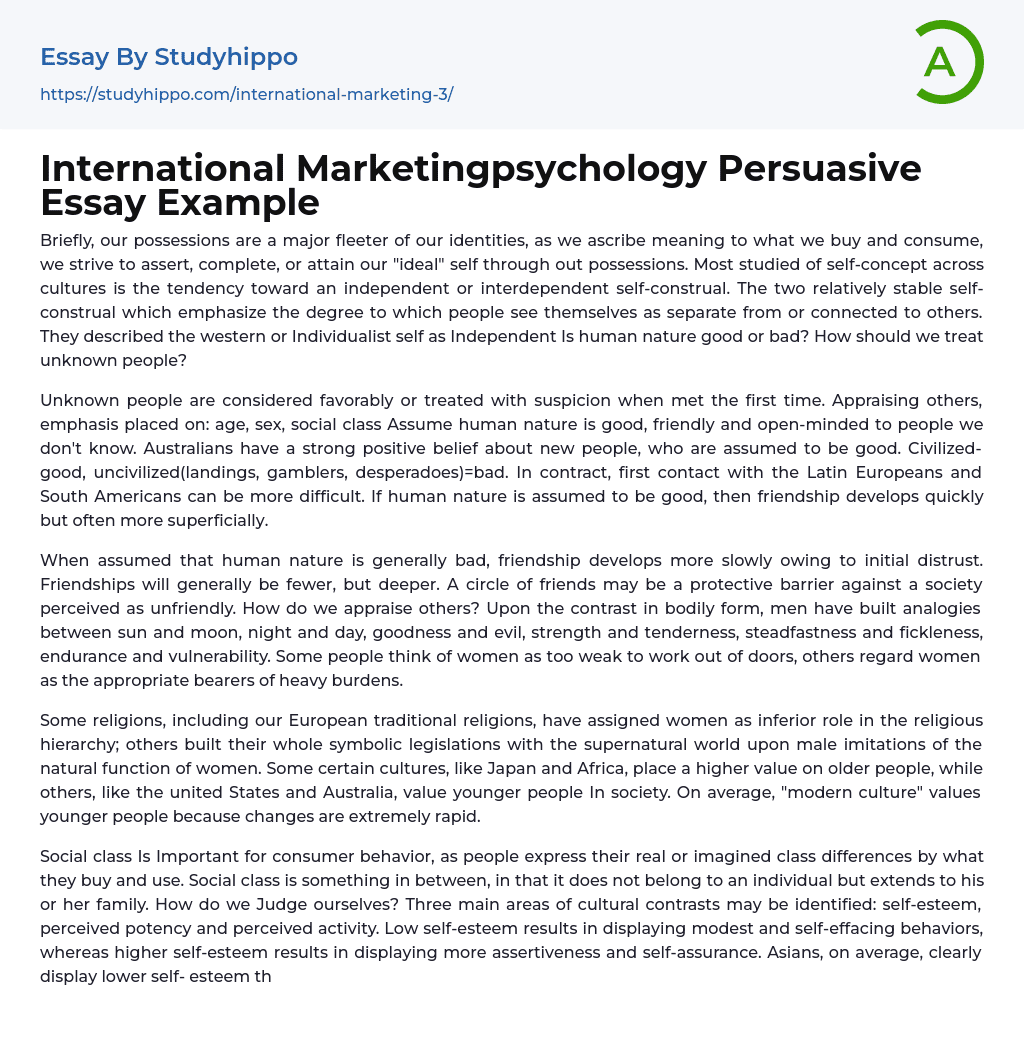

International Marketingpsychology Persuasive Essay Example
The significance we give to our possessions determines how they shape our identities. Expressing or achieving our "ideal" self is often tied to what we own. Different cultures have different concepts of self, with independent and interdependent self-construals being the main types. These self-construals determine whether individuals see themselves as separate from or connected to others.
When encountering unfamiliar people, initial perceptions are influenced by factors like age, gender, and social class. Assuming that human nature is inherently good, people tend to be friendly and open-minded towards unknown individuals. Australians, for example, generally hold positive beliefs about newcomers and assume their goodness. However, if there is an initial assumption that human nature is bad, friendships develop more slowly due to mistrust. While these friendships may be fewer in number, they tend to be deeper relationships
.... A circle of friends can serve as a protective barrier against an unfriendly society.
Assumptions about human nature influence how we evaluate others. Throughout history, men have compared contrasting elements such as the sun and moon, night and day, strength and tenderness primarily based on physical differences.
There are differing opinions on women's strength for outdoor work, with some believing they lack it and others thinking they excel at carrying heavy loads. In certain religions, women are considered inferior in the religious hierarchy, and there are symbolic laws based on men imitating women's natural functions. Different cultures value age differently, such as Japan and Africa prioritizing older individuals while the United States and Australia prioritize younger people due to rapid changes in modern culture. Social class significantly influences consumer behavior as individuals use their purchases to express real or perceive
class differences, extending to their families as well. Cultural differences can be observed in self-esteem, perceived power, and activity levels. Individuals with low self-esteem tend to display modesty and self-effacing behaviors, while those with higher self-esteem exhibit assertiveness and self-assurance. Asians generally have lower self-esteem compared to Westerners. Individuals who have a high level of personal activity often boast about being workaholics, working on weekends, and finding satisfaction in overworking themselves.
People with low self-esteem, perceived powerlessness, and reduced activity levels feel powerless when comparing themselves to others.On the one hand, individuals who are overly confident are willing to take on challenging tasks despite the risk of failure. On the other hand, in individualist cultures, there is a clear distinction between individuals and their community, whereas collectivist cultures blur these boundaries. The differences between individualism and collectivism can be explained using the 'rice argument'. Individualistic beliefs emphasize that personal initiative, effort, and achievements are best developed at an individual level due to variations among individuals. Combining individual achievements does not result in any loss, and society should prioritize individual freedom, value high achievers, and emphasize uniqueness. In contrast, collectivism argues that initiative, effort, and achievements are best nurtured within groups as individuals function as part of a collective reality. Collective accomplishments differ from those achieved individually and surpass the sum of their parts. Society must prioritize group coherence and social harmony even if it inhibits individual accomplishments. Collectivism is typically associated with traditional culture while individualism is inherent in modern culture. Throughout history, self-awareness has evolved with a focus on the individual as seen through the increasing popularity of self-centric items such as mirrors, self-portraits,
and chairs since the Middle Ages.It is important to note that there is not always a clear distinction between individualism and collectivism. Even in societies prioritizing individualism, people still belong to groups and identify themselves as part of something greater. Similarly, individuals in collectivist societies desire to express their personal identity. However, individualist societies prioritize cooperation rooted in individuality and rationality at a higher level.
- Advertising essays
- Audience Theory essays
- Competitor Analysis essays
- Consumer essays
- Marketing Management essays
- Marketing Mix essays
- Marketing Plan essays
- Marketing Research essays
- Marketing Strategy essays
- Point Of Sale essays
- Price essays
- Procurement essays
- Product essays
- Product Differentiation essays
- Promotion essays
- Promotion And Marketing Communications essays
- Retailing essays
- Trademark essays
- Anheuser-busch essays
- Brands essays
- Detergent essays
- Product Placement essays
- Research Design essays
- New Product Development essays
- Advertisement essays
- Brand essays
- Sales Promotion essays
- Advertising campaign essays
- Consumer behaviour essays
- Offer And Acceptance essays
- Wal-Mart essays
- Discover essays
- Abnormal Psychology essays
- Social Psychology essays
- Developmental Psychology essays
- Jean Piaget essays
- Positive Psychology essays
- Classical Conditioning essays
- Counseling essays
- Psychoanalysis essays
- Educational Psychology essays
- Behaviorism essays
- Authority essays
- Operant Conditioning essays
- Maslow's Hierarchy Of Needs essays
- Mental Health essays
- Personality Psychology essays
- Psychotherapy essays
- Family Therapy essays
- Stanford Prison Experiment essays



